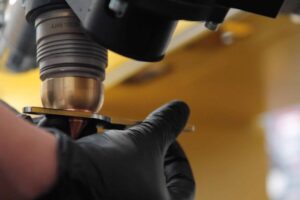When it comes to plasma cutting, a glance through our blog articles and our knowledge base will already tell you a few, very useful things;
Consumables for plasma cutters, such as nozzles, electrodes, swirl rings and retaining caps are an ongoing expense and are all components that will need constant inspecting and replacing if necessary.
A company such as Ajan, who manufacture and distribute everything in-house including their own consumables, are able to supply said consumables with the absolute minimum of fuss and expense to the consumer. Now, with those things firmly in mind, let’s move on to the details, and learn a little more about these consumables. What are the signs that one or more might need replacing?
Nozzles
Thinking about what function a nozzle actually performs can offer valuable insight into those times when it may be on its last legs. In short, the nozzle’s orifice constricts the arc, even though the nozzle is cooled somewhat by the gasses swirling down through it, heat still plays a crucial role and over time the nozzle’s orifice wears, becoming wider and uneven. The knock-on effect of a worn nozzle is loss of constriction and loss of heat through an arc that is not as concentrated as it should be. A visual inspection of the nozzle, checking for an exceptionally large or misshapen orifice will tell you all you need to know.
Electrodes
Made of a blend of copper and highly conductive materials, these carry the current from torch to plate. As it is used over time the conductive elements (tungsten and hafnium) turn molten and during the cutting process, exit out through the nozzle, forming a pitted hole at the electrode’s front. If a visual inspection finds that pitted front deeper than around 0.8mm then it is time to change the electrode. Cutting will be severely affected at this point, and you may notice a green glow to your arc as the conductive materials are all gone, leaving the copper to burn away. The far greater temperatures caused at this stage can damage other components and is a stage you need to take great lengths to avoid.
Best practice with both nozzles and electrodes is to replace both at the same time, as the effectiveness of one often depends on the other.
Swirl rings
A swirl ring can lose integrity over time and constant heating and cooling, although this isn’t common. Most issues come from drops and knocks cracking the ring and impeding its ability to channel gasses as it should. As a general rule of thumb, for every five to ten sets of electrodes/nozzles you replace, then also consider replacing your trusty swirl ring.
Retaining caps & Shields
Much the same as the swirl rings inspect retaining caps for cracks or damage, also check for slag build-up on the end of the shield as it can often constrict airflow. Replace them as needed but don’t expect to replace them as often as electrodes or nozzles.
Published 18th June 2018

